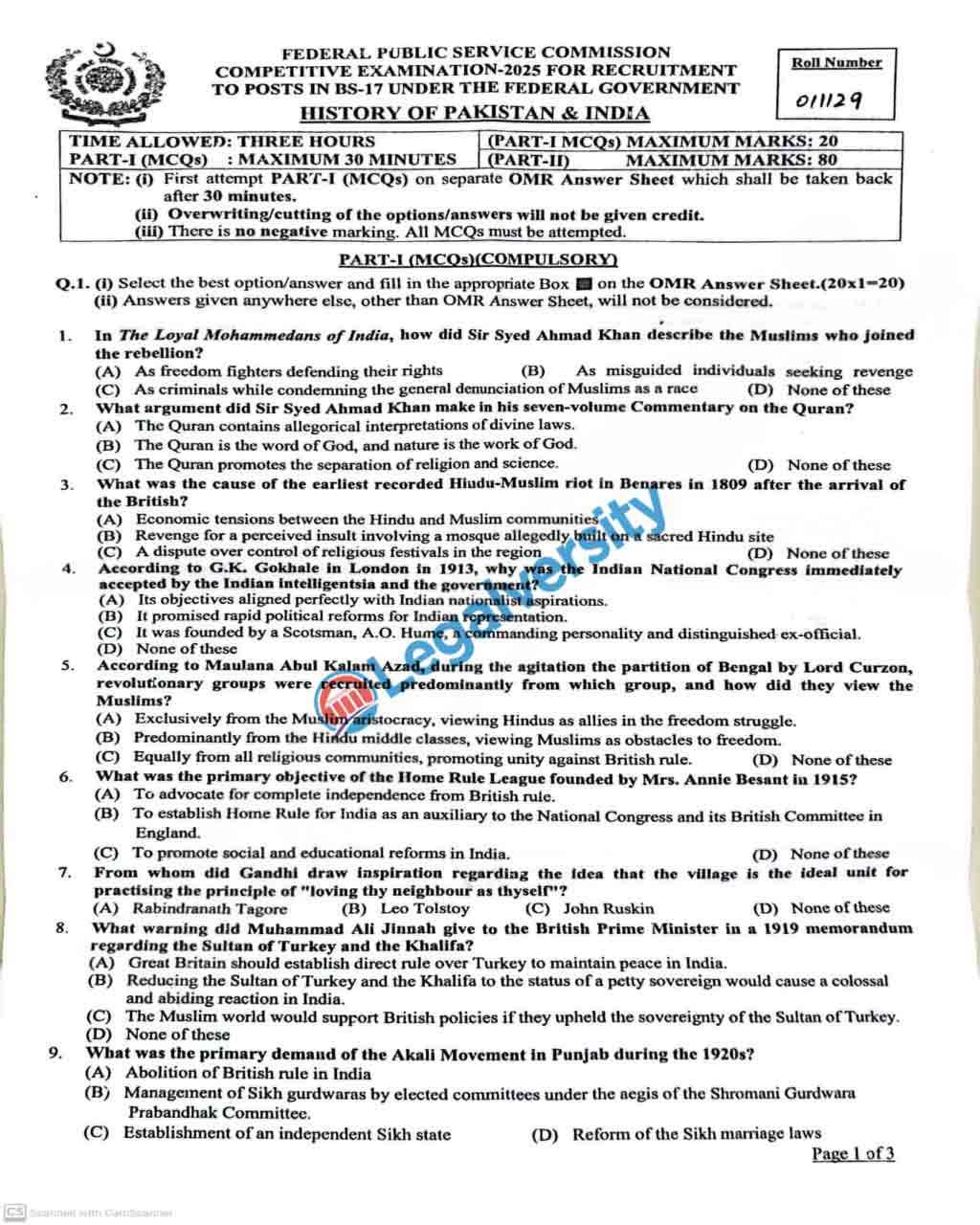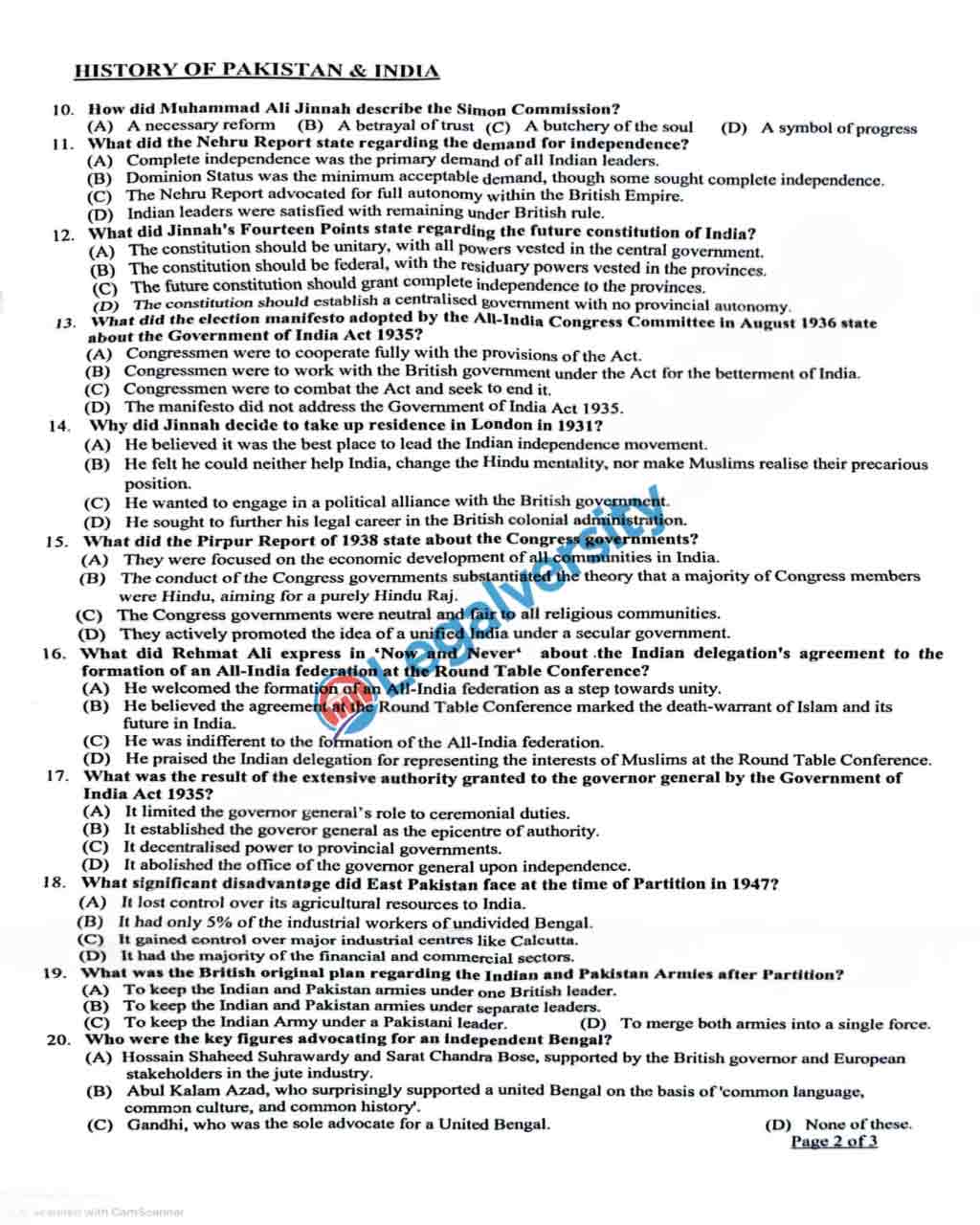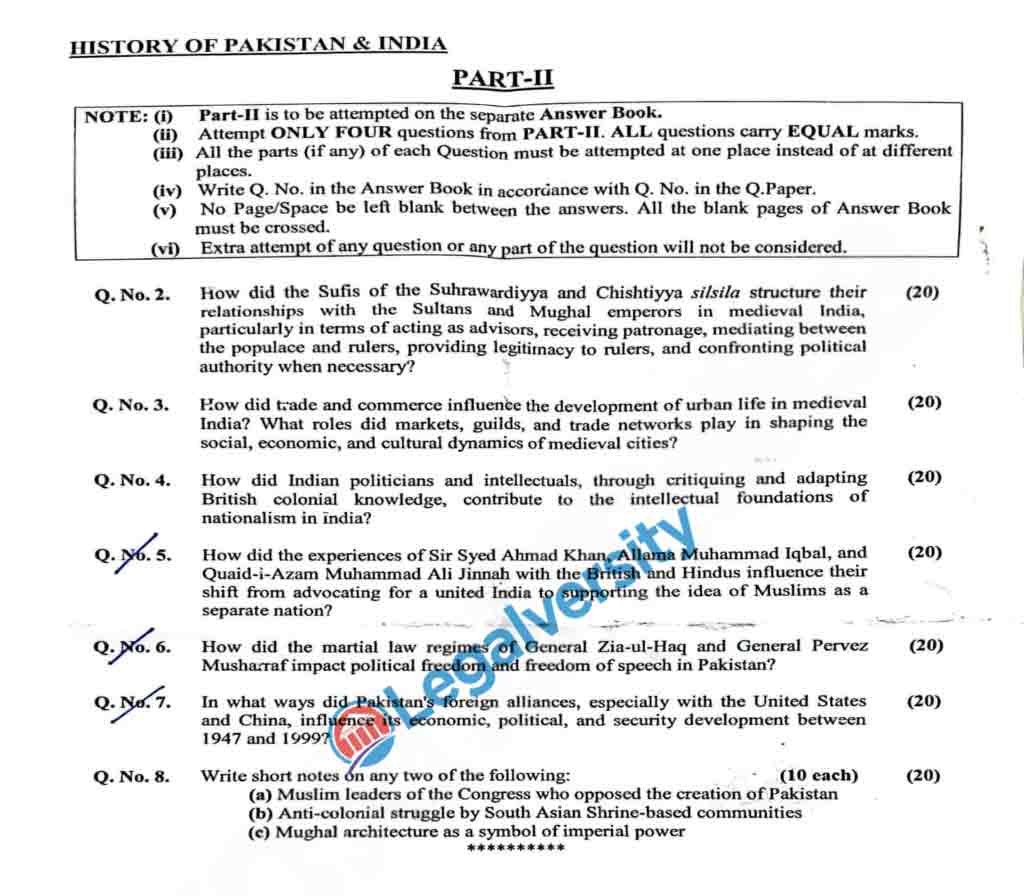The paper on History of Pakistan & India is optional in the CSS competitive examination 2025. Here, you will find the CSS History of Pakistan & India past Paper 2025. I will also provide a summary of the paper, in which you will analyze what topics were given and how difficult they were. This lets you better understand the concept of paper and prepare well for future examinations.
CSS History of Pakistan & India Past Paper 2025
Q1. how did the Sufis of the Surawardiyya and Chishtiyya Silsila structure their relationships with the Sultans and Mughal emperors in medieval India, particularly in terms of acting as advisors, receiving patronage, mediating between the populace and rulers, proving legitimacy to rulers, and confronting political authority when necessary?
Q2. How did trade and commerce influence the development of urban life in medieval India? What roles did markets, guilds, and trade networks play in shaping the social, economic, and cultural dynamics of medieval cities?
Q3. how did Indian politicians and intellectuals, through critiquing and adapting British colonial knowledge, contribute to the intellectual foundations of nationalism in India?
Q4. how did the experiences of Sir Syed Ahmad Khan, Allama Muhammad Iqbal, and Quaid-e-Azam Muhammad Ali Jinnah with the British and Hindus influence their shift from advocating for a united India to supporting the idea of Muslims as a separate nation?
Q5. How did the martial law regimes of General Zia-ul-Haq and General Pervez Musharraf impact political freedom and freedom of speech in Pakistan?
Q6. In what ways did Pakistan’s foreign alliances, especially with the United States and China, influence its economic, political, and security development between 1947 and 1999?
Q7. Write short on any two of the following:
- Muslim leaders of the Congress who opposed the creation of Pakistan
- Anti-colonial struggle by South Asian Shrine-based communities
- Mughal architecture as a symbol of imperial power
Critically Analysis of the Paper
The Sufis of Suhrawardiyya and Chishtiyya Silsilas were instrumental in developing political and religious life during medieval India. Unlike the Chishtis, who remained more or less aloof from rulers, the Suhrawardis were closely aligned with the state. They served as advisors to Sultans, providing spiritual legitimation to their rule while receiving patronage through land grants and endowments. The Chishtis, however, liked to stay aloof from state politics, exercising power through popularity among the masses and not directly through identification with rulers. Both Sufi orders, however, acted as intermediaries between rulers and the public, defusing tensions in times of political or social turmoil. They also challenged authority at times when rulers strayed from Islamic teachings or pursued repressive policies. Trade and commerce were the lifeblood of medieval Indian urbanization.
Prosperous cities like Delhi, Lahore, and Surat became important economic hubs, fueled by widespread inland and sea trade networks. Markets served as centers of economic activity, where merchants, artisans, and traders traded goods from Persia, Central Asia, and the Indian Ocean world. Guilds were instrumental in controlling trade practices, establishing quality standards, and guaranteeing fair wages. These trade networks also enabled cultural exchanges, as ideas, religious beliefs, and technologies propagated across regions, enriching Indian cities’ social fabric.
Trade-based city prosperity encouraged the rise of architectural marvels, learning institutions, and artistic expression centers. The criticism and adaptation of British colonial knowledge were key to molding Indian nationalism. Indian thinkers interacted with British economic, administrative, and legal systems to lay bare their contradictions and injustices.
Intellectuals such as Dadabhai Naoroji challenged the British assertion of benevolent domination through the articulation of the economic drain theory. Others, such as Bal Gangadhar Tilak and Mahatma Gandhi, drew upon Western political thought to politicize the masses. By mixing indigenous traditions with modern political thought, Indian leaders developed a distinct nationalist ideology, opposing colonial domination and calling for self-rule.
The political evolution of Sir Syed Ahmad Khan, Allama Iqbal, and Quaid-e-Azam Muhammad Ali Jinnah was heavily impacted by their encounters with the British and Hindu leadership. Sir Syed initially advocated for Hindu-Muslim harmony, but upon seeing Hindu nationalist forces and the Hindi-Urdu controversy, he spoke in favor of Muslim uniqueness. Iqbal’s idea of an independent Muslim identity arose in reaction to British policy and Muslim marginalization within a Hindu-dominant India.
Jinnah, a keen advocate of Hindu-Muslim cooperation, increasingly turned towards the Two-Nation Theory following his observation of Congress’s majoritarianism, especially during the Nehru Report (1928) and Congress ministries (1937-39). Their experiences under colonial domination and Hindu politics prompted them to call for a separate Muslim state, which the establishment of Pakistan in 1947 fulfilled.
The martial law administrations of General Zia-ul-Haq and General Pervez Musharraf had drastic repercussions on political liberty and freedom of expression in Pakistan. Zia-ul-Haq’s regime (1977-1988) was characterized by strict censorship, repression of political opposition, and Islamization of legislation, such as the imposition of severe media curbs. Musharraf (1999-2008), though initially championing media liberalization, repressed dissent when confronted, especially during the lawyers’ movement (2007) and the declaration of emergency rule. Both governments employed coercion and legal means to restrict democratic expression and suppress political opposition.
Pakistan’s foreign relationships with the United States and China considerably influenced its economic, political, and security policies from 1947-1999. The US-Pakistan relationship, established early on in the Cold War, drew military and economic assistance but also involved Pakistan’s involvement in geopolitical rivalries, such as its participation in the Afghan Jihad of the 1980s. Economic reliance on American support frequently entailed political concessions.
While so, Pakistan’s relationship with China offered a strategic alternative ally, particularly following the 1965 and 1971 conflicts with India. China’s assistance played a key role in nuclear development and defense modernization, as well as supporting economic initiatives. Yet, these alliances also resulted in Pakistan’s policies being frequently influenced by external pressures, sometimes at the expense of internal stability.
Short Notes
1. Several Muslim leaders in the Indian National Congress were against the establishment of Pakistan, and they felt that Muslims could prosper in a single India. Leaders like Abul Kalam Azad and Khan Abdul Ghaffar Khan contended that partition would make Muslim communities weaker and shatter centuries of living together. Despite their resistance, the increasing communal divide and the inability of Congress to include Muslim concerns resulted in the eventual partition.
2. Mughal architecture was a strong symbol of imperial power, fusing Persian, Indian, and Central Asian elements to demonstrate power and cultural dominance. Buildings such as the Taj Mahal, Red Fort, and Jama Masjid not only reflected Mughal prosperity but also perpetuated the notion of divine kingship. These monuments, which featured intricate calligraphy and symmetrical patterns, showed the grandeur of the empire, leaving a permanent mark on South Asian architectural history.
View CSS History of Pakistan and India past paper 2025



You can also read the CSS Notes and view all previous papers on CSS

CSS